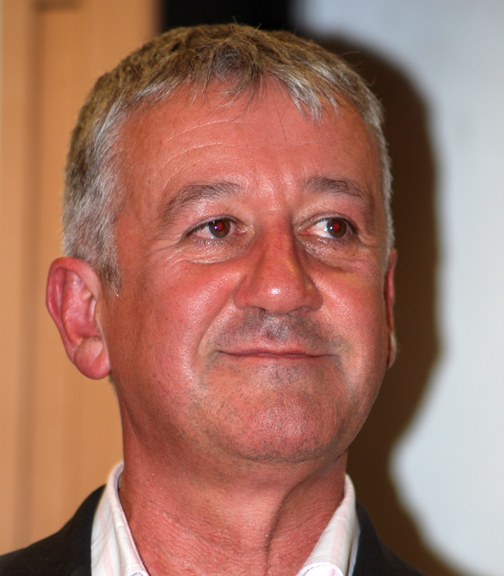“It was early in the morning when I heard a blast,” said Allan Little, veteran BBC war reporter.
“You want to believe it was the sound of something heavy and metallic dropped from a large height on a construction site. The unmistakable ‘dugga-dugga-dugg’ of machine gun fire let no more room for wishful thinking of that kind and soon the air of central Kabul was filled with the noise of the fight.”
Award-winning journalist Little began his talk at the University of Lincoln on October 4th by recalling his experiences of Kabul under attack from the Taleban in January this year.
“You could taste on your tongue the acrid, gunpowder burn of spent rifle rounds. From our listening post it seemed that the city centre exploded in a kind of orgy of grotesque violence — indiscriminate, chaotic.”
Yet these attacks were not random, but highly organised, Little explained. The violence wasn’t indiscriminate, either: “What was remarkable about it given the ferocity of the attack was how few people were actually killed. The Taleban, we learned later, having failed to storm the government buildings that they had first targeted, sought to shelter elsewhere.
“At least four went into a crowded shopping centre. If their intention had been to kill as many people as possible, it would have been easy to do it here. But they didn’t. They ordered everyone, shoppers and shopkeepers alike, out.”
While the violence was exploding in Kabul, a Taleban spokesman called a news agency to announce that 20 militants were taking part in the attack.
“The public relations management was as important to the perpetrators, as the co-ordination of the attack itself,” Little said.
“This care, this determination to avoid civilian deaths, is now part of the conflict in Afghanistan. It’s something the Taleban shares with NATO … They, like NATO, are engaged in a battle not just for power and territory, but for the hearts and minds.”
Little has reported on many of the major conflicts of the last 20 years. Unembedded reporting is best way, he argues, to get the clearest possible picture of war amidst the public relations battle. He recalled reporting in war-torn Bosnia in the nineties.
“At night you could see the fires from the ethnic cleansing — the flames would be the only light on the landscape. It was eerie to watch,” Little said.
As villages were being burned to the ground and the villagers slaughtered, Little came across a group who had escaped from one area. They had been walking for 48 hours and he found them coming through a forest clearing. As they emerged, Little said they looked like a “procession of the dead”, given their exhaustion.
“Among them, one man walked towards us alone … He’d become separated from his wife and was anxious that she hadn’t made it … he said he was 80. He described how the town’s defences had collapsed suddenly, without warning, in the face of a Serbian advance. Everyone had had to flee at that moment with whatever they could grab at that moment.
“He was so pale, that his skin, stretched across the bones of his face, seemed almost translucent, and there was a livid, blue bruise on his forehead. So when we’d interviewed him, ‘may I ask’, I said finally, ‘whether you are a Muslim or a Croat?’. The memory of what came next shames me, and I hope you understand why … ‘I am,’ he said, ‘a musician’.
“That was how the war was then. It unfolded in front of your camera lens. It was hard and dangerous, but it was accessible.”
Another example he gave of unembedded journalism getting to the real story was from the first Gulf War which he was reporting on from Baghdad.
“One morning, allied aircraft fired bunker busting into a building which was thought to be a military command bunker. It was, in fact, an air-raid shelter. Hundreds of people, almost all of them women and children, were sleeping in there and almost all of them died instantly. When we arrived they were still pulling the bodies from the burning remains of the building. Soon I was on the air reporting what I’d seen.”
One Iraqi man showed Little identity cards for his wife and five children — all perished in the shelter.
Now unembedded journalists are at risk of kidnap and murder, particularly in the Middle East. This, he says, allows coalition forces the overwhelmingly dominant narrative in the reporting of Afghanistan and Iraq. Journalists simply can’t put themselves outside of the safety of embedding with military units as it’s too risky. This makes it much harder to challenge the coalition’s official version of events.
“Information is part of the war effort,” Little said.
“What we report, the way we report it, is therefore a key part of the military campaign. The military have a term for it. They call it ‘Information Operational Effect’… By 2003 we were regarded not as independent reporters, but as potential assets.”
When British forces took control of Basra in the most recent Iraq war, a British colonel told Little he was “going to have prominant BBC war correspondent flown in there, along with one of CNN’s best known reporters, so we can start broadcasting right away”. Little challenged him.
“I asked him when these journalists had started working for the British Army? When the British Army had assumed the right to deploy independent war correspondents? But he knew that he controlled access and that we would jump at the chance to be choppered in.”
In a warning for war reporters, Little said: “We must work hard to keep our distance to ensure that as reporters embedded with the armed forces we don’t start to see the war from their point of view, or through their eyes.”
